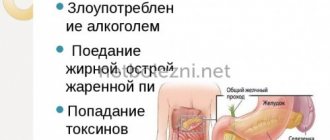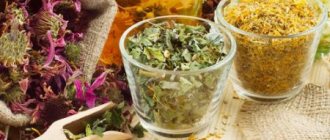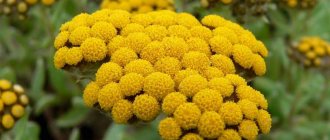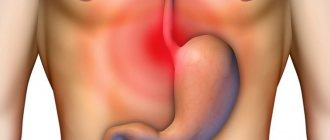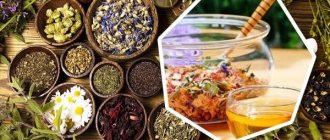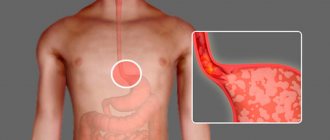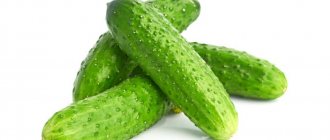Causes of heartburn
Heartburn is a burning sensation behind the sternum that rises from the epigastric region. The immediate cause of heartburn is the release of food debris from the stomach into the digestive canal, called reflux. A pronounced release of acidic juice leads to irritation of the esophageal tissue and, as a consequence, erosions and ulcerative lesions.
Several reasons can aggravate heartburn:
- Unhealthy diet: eating fatty, fried foods, overeating, being overweight.
- Drinking alcoholic beverages, smoking tobacco, seasonings that irritate the gastric mucosa.
- Taking medications on an empty stomach: aspirin, sedatives and antidepressants, hormones, painkillers, blood pressure medications, bronchial antispasmodics.
- Spontaneous relaxation of the lower sphincter.
- Excessive exercise: running and bending, while lying down.
Often the reason is quite simple: heartburn, as a result of discomfort in the internal organs when wearing tight clothes or tightened belts. Some foods can cause fermentation and gas formation, which can also cause heartburn. If the dishes are prepared incorrectly, the food is hard and heavy, it is possible to solve the problem yourself.
Pros and cons of folk remedies
The advantage of folk remedies is that they are always available in any home. These are natural, often inexpensive products that will provide first aid in case of discomfort in a timely manner.
Another undeniable advantage is the huge variety of ingredients and recipes, which will allow you to choose a more suitable treatment method.
Folk remedies for relieving heartburn are recommended for use by nursing and pregnant women, when the use of drugs that relieve spasms is not desirable. In this case, milk, grapefruit and carrot juices will not only help, but also be beneficial. Pumpkin seeds are very useful: in addition to relieving heartburn, they have a healing effect.
The most common folk remedy for heartburn in everyday life is baking soda. 0.5 tsp is enough. dilute in 100 g of water and drink. Heartburn will go away quickly, but the carbon dioxide formed during the reaction will cause an additional release of acid and provoke increased heartburn.
Activated carbon works similarly. 3-4 tablets can block excess acid production, but can cause constipation and dehydration. The negative side of cheap remedies: the condition improves quickly, but deterioration can also occur quickly. Frequent use leads to gastritis, and in case of gastrointestinal pathologies, it provokes exacerbation of diseases.
Some products produced by bees, such as propolis and honey, cause allergic reactions in some people.
Benefits of using herbal remedies
Herbs for heartburn are a proven method available for self-treatment at home. The use of plants during a therapeutic course has advantages over the use of drugs:
- no contraindications other than a possible allergic reaction to the components;
- no side effects;
- unhindered access to ingredients;
- natural composition.
Herbal plants have no contraindications for use; they are prescribed to drink for heartburn with high acidity, even for young children. To avoid an allergic reaction in case of intolerance to the components, you should consult a doctor and undergo laboratory tests.
When properly prepared, effective herbs, infusions, decoctions, and teas do not have side effects on the functioning of the body. Medicinal plants are cheaper than medicinal analogues of domestic and foreign production. Herbs have a natural composition, so they will not harm your health.
Herbal decoctions to treat discomfort
Medicinal herbs are used, both fresh and dried:
- Flea plantain seeds. They have an enveloping effect. Pour 100 g of seeds into 200 ml of boiling water for 30 minutes. Drink 0.5 cups/2 times a day after meals.
- Calendula flowers. 1 tbsp. pour 1 cup of hot water over calendula and leave for 30 minutes. Take in small portions throughout the day.
- Centaury. Characterized by anti-inflammatory and analgesic properties. 2 tbsp. centaury pour 0.5 liters of boiling water, stand for 30 minutes. Drink 1/2 cup on an empty stomach.
- Grated ginger root will relieve the burning pain. To do this, just chew 4 g of the product.
For increased intestinal acidity, decoctions of yarrow, rose hips, St. John's wort, mint, calamus rhizome, angelica root, and fennel are suitable. Green tea is very gentle. It soothes and slightly reduces stomach acidity. A rosehip decoction rich in vitamin C will speed up the healing of damaged intestinal tissue.
For gastritis with low acidity - juice and plantain leaves.
Important! Herbal infusions should be consumed in small portions, no more than 1.5 glasses per day. An incorrectly selected herbal mixture can harm the body.
Aloe
The plant is known for its beneficial qualities.
Aloe contains:
- vitamins A, C, E and group B;
- beta-carotene is a powerful antioxidant that protects body tissues from the effects of radicals;
- polysaccharides – participate in the activation of immune processes;
- aloin - promotes wound healing and elimination of inflammatory processes;
- amino acids and trace elements.
Only the lower and large leaves of the plant are used. Before harvesting, the leaves must be kept in the refrigerator at a temperature of +2 °C for at least 10 days. This action will launch the process of synthesis of substances, stimulating beneficial processes in the body.
Ways to use aloe:
- Briefly relieve heartburn. To do this, dilute 30 ml of fresh juice in 150 ml of water. Drink in small sips. The pain will go away in 10-20 minutes.
- Use for a long course to treat colitis and gastritis. The combination of aloe with herbs enhances its anti-inflammatory effect.
- Aloe with honey. Mix 100 g of aloe and 100 g of fresh honey. If the honey is candied, preheat it to a liquid state. Drink 1 tbsp before meals. / 3 times a day. Duration of treatment is 3 weeks. For long-term storage, the mixture can be diluted with alcohol.
- Aloe with plantain. Grind aloe and plantain leaves in a meat grinder and squeeze out the juice. Mix 1 portion of aloe with 1 portion of plantain and 1 portion of water. The mixture is taken before meals, 1 tbsp. /3 times a day.
- Potato juice with aloe. Mix 1 portion of aloe with 1 portion of freshly squeezed potato juice and 1 portion of liquid honey. Take 1/2 cup in the morning on an empty stomach.
- Treatment of gastritis with low acidity. 1 portion of squeezed aloe juice + 1/4 part of a 95% ethyl alcohol solution. Drink 1 tsp. half an hour before meals / 3 times a day.
Agave is a powerful biostimulant and promotes overall health of the body.
Contraindications for the use of aloe juice: hypertension, pregnancy, during exacerbation of gastrointestinal diseases, with renal pathologies, the presence of tumor formations.
Pumpkin, flax and sunflower seeds
Only dried seeds are used: the oils from the seeds neutralize hydrochloric acid and form an oily protective film on the surface of the mucous membrane.
The consumption rate of dried seeds is 80-100 g per day; there is no fundamental difference in their use.
Ways to use seeds:
- Grind 100 g of flaxseed into powder, brew with 1 cup of boiling water. Let stand until it reaches the consistency of jelly. Drink jelly after eating.
- Eat 100 g per day of sunflower seeds, pumpkin seeds or ground flax seeds.
- A tasty folk remedy is almonds. It is enough to treat the nut with boiling water and chew it slowly. Very soon the heartburn will go away.
The use of seeds with husks is contraindicated: there is a possibility of infection or inflammation of appendicitis. If the husk gets into the mouth, it can cause pharyngitis.
Oats
A folk remedy for heartburn is oats. This is a valuable product containing beta-glucans - dietary fiber that helps restore digestive processes. Oats also contain: protein, fiber, starch, amino acids and vitamins. Used for high acidity. Regular use of decoctions will help get rid of colitis and gastritis.
Ways to eat oats:
- Sprouted oat grains are the most popular product. Sprout 800 g of oat grains. After the sprouts appear, grind in a meat grinder and leave in 2 liters of water for 3 hours. Strain the resulting mass. The consistency of the liquid should resemble jelly. Take in the morning 1-2 hours before meals for up to 2 months.
- Oatmeal broth. Pour 100 g of oat grains into 2 liters of water. Cook for 1 hour, stir and strain. The decoction is taken before meals, 1/2 cup or throughout the day.
- Oatmeal kvass. Place 300 g of washed oats and 50 g of sugar in a large jar. Pour in unboiled water. Keep the drink in a dark, cool place for 24 hours. Then drain the liquid, fill it again with clean water and add 70 g of sugar. A day later the kvass is ready.
Contraindications for use: the presence of kidney and gallstones. Excessive consumption of oats can lead to active passage of stones or stagnation of bile.
Cabbage
Fresh white cabbage is rich in vitamins C, B1, PP, U, which are necessary for the good functioning of the gastric organ. Cauliflower contains a lot of vitamin K, which affects blood quality. Cabbage is a source of salts and acids necessary for the body, such as folic acid.
Disadvantage: fresh cabbage contains fiber, which has an irritating effect on the mucous tissue of the digestive system; the product should be taken only in the stage of remission of gastrointestinal diseases.
For gastrointestinal diseases, freshly squeezed cabbage juice is used; it contains less fiber than fresh vegetables.
Cabbage juice. Chop the cabbage and squeeze out the juice. Drink within 30 minutes. before meals, 1 glass / 2 times a day. Cabbage juice can be diluted with carrot, apple, celery juice or honey. Still, you shouldn’t give up fresh cabbage salads. In the absence of contraindications, every person needs vitamin salads to improve intestinal function.
Cabbage salad recipe: chop up to 200 g of cabbage, finely grate 1 beet, 1 apple and 2 carrots, bell pepper, season with unrefined oil, spices, sugar, salt.
Mumiyo
It is used both to relieve heartburn and to treat gastritis.
The one-time rate of use of mumiyo is calculated based on the person’s weight:
| Item no. | Body weight, kg | Shilajit requirement per 1 dose, g |
| 1. | 70 | 0,2 |
| 2. | 70-80 | 0,3 |
| 3. | 80-90 | 0,4 |
| 4. | more than 90 | 0,5 |
Dissolve one dose of mumiyo in 50 ml of milk water. Take morning and evening 1.5 hours before meals with high acidity and 0.5 hour with low acidity/2 times a day. The treatment period is 4 weeks. For gastritis, use 0.4 g mummy 1.5 hours before meals / 2 times a day. The duration of treatment is 21 days.
Eggshell
A folk remedy for heartburn, eggshells, are more effective for isolated attacks. It is recommended to use only homemade chicken eggs with white shells.
Applicable:
- For increased heartburn: wash a raw egg, separate the shell, wash, dry and crush into flour. Take 0.5 tsp. powder with water.
- If the acidity is low, prepare a mixture: a mixture of 1 tsp. honey, 0.5 tsp. citric acid and shell powder of 1 egg pour 200 ml of water. Take 1 tsp/2 times a day between meals.
For long-term treatment with eggshells, a monthly course of fish oil is recommended.
Apples
The fruits contain pectin, which has astringent and enveloping properties. Apples also contain coarse fiber, and if the fruit is consumed in large quantities, there is a risk of exacerbation of chronic gastrointestinal diseases.
Use of the fruit:
- 1 apple eaten on an empty stomach will relieve heartburn. But after 30 minutes. After taking it, you need to eat a hearty meal, otherwise the acids and sugar contained in the apple will begin to stimulate the production of gastric juice.
- Apple with honey or freshly prepared apple juice.
Honey based products
Honey contains many useful components: vitamins B, C, E, K, folic acid, and up to 80% carbohydrates. The action of honey is based on the regeneration of gastric tissue and restoration of intestinal functions. May, linden, and acacia honey is used as a remedy.
Ways to take honey:
- Stir 1 tsp. honey in 1 glass of water. Drink on an empty stomach 2 hours before or after meals / 2 times a day for 4 weeks.
- Honey with aloe. Add 100 g of aloe juice to 100 g of honey. Take 1 hour before meals / 3 times a day.
Important! For gastrointestinal diseases, taking honey on an empty stomach is prohibited. Excessive consumption of honey irritates the intestinal tissue.
Milk
A product with an alkaline environment that can block excess acid. The protein in milk increases the body’s ability to heal inflammation and restore mucous epithelial tissue. The milky film that forms on the walls of the stomach delays the action of acids and soothes the intestinal tissue.
Calcium in milk is absorbed more intensively in the evening, so a glass of milk with a teaspoon of honey will relieve stomach pain and soothe you during the night.
Yogurt, kefir, low-fat cottage cheese and milk porridge will deliciously soothe heartburn. But the relief effect can last no more than 20 minutes. Milk stimulates the secretion of juice, and heartburn will occur again.
Kalina
Viburnum juice can suppress excess acid and enzyme formation. A folk remedy for heartburn is viburnum jam, a tasty and healthy product. Prepare: 1 tbsp. Dilute viburnum jam in a glass of water and drink as tea.
Drink made from viburnum berries. Use 1 part berries to 4 parts water. Brew and drink 1/2 glass before meals / 3 times a day.
Celery root
Fresh and dried celery roots are used:
- Grind the roots of the fresh plant and take 2 tbsp. 0.5 hour before meals / 3 times a day.
- Fresh celery salad: grate celery root, carrots, apple on a coarse grater. Chop the onion and parsley, add salt, add a pinch of sugar and season with oil.
Peas
The product contains a lot of vitamins B, B2 and PP, which are involved in the oxidative processes of the body. Vitamins A and C help boost immune defense.
Both fresh and dry peas are used to suppress heartburn:
- Chew 3-4 fresh peas slowly and thoroughly.
- Place a handful of dry peas in boiling water. 3-4 peas must be chewed thoroughly.
- Grind dry peas in a meat grinder. A small dose of 4 peas will relieve an attack of heartburn.
Contraindications in the use of the product: the high purine content in peas promotes the deposition of salts in joints, kidneys, and tendons. Fresh peas can cause fermentation in the stomach.
Buckwheat
The product contains a complex of amino acids, microelements, vitamins B1, B2, B9, PP, E. Green buckwheat is considered especially valuable - a powerful antioxidant with cleansing functions.
Several ways to use buckwheat:
- Grind the cereal into flour and take 1/2 tsp. 3 times a day between meals, with a glass of water. Treatment is carried out for 1 month. If green buckwheat is used, it must first be calcined.
- For frequent heartburn, it is advisable to eat unsalted buckwheat porridge with unsalted natural butter every day.
Raw buckwheat is more effective than heat-treated buckwheat. It is not recommended to use the product for gastrointestinal diseases, pancreatitis, or a tendency to thrombosis.
Fresh juices
Fresh vegetable juices effectively reduce heartburn:
- Potato juice. Peel 3 large potatoes, grate and squeeze out the juice. Leave the liquid for 3 minutes. For gastritis, take 30-50 g of juice in the morning on an empty stomach for 10 days, 30 minutes before meals. After a break of 10 days, repeat the course.
- Pumpkin juice. It is taken similarly to potato juice.
- Carrot juice. Helps reduce acidity as quickly as possible. Take 1/2 cup up to 3 times a day. Grated and boiled carrots will also help with heartburn.
- Fresh beet and cabbage juices. Take 1/2 cup up to 3 times a day. It is recommended to add a little parsley, dill, mint or ginger to drinks. They will raise the overall tone of the body and add an original spicy taste to the drink.
For low acidity, tomato, apple, pomegranate, cherry, cranberry, citrus, and grape juices are used. Fruit juices contain a lot of fructose, so the consumption of such drinks by patients with diabetes should be strictly limited.
It is advisable to pay attention to other drinks, such as squash, cucumber, and birch juices.
Mineral water
A folk remedy for heartburn, mineral water, is known to many connoisseurs of traditional medicine. Quickly relieves burning sensation, regulates the functions of the gastrointestinal tract and pancreas.
Based on its composition, mineral water is divided into types:
| Chloride waters | Used for gastritis with low acidity. These are: “Ekaterinogorskaya”, “Essentuki No. 4”, “Zheleznogorskaya” |
| Sulphate waters | stimulate the flow of bile. These are: “Ivanovskaya”, “Kashin”, “Moskovskaya” |
| Alkaline waters | used for gastritis with high acidity. The most common are Borjomi and Essentuki. |
Rules for drinking alkaline water:
- remove gases from water by settling;
- drink warm water 0.25 glasses 3 times a day an hour after meals in small portions.
Mineral water does not cure heartburn, but suppresses it for a short time. If the burning sensation persists, immediately stop drinking water and consult a doctor.
It’s easy to prepare alkaline water yourself at home: bring regular filtered water to a boil and then quickly cool it by placing a bowl of boiling water in a bathtub or large container of cold water. Store boiled water in a closed container and drink cooled throughout the day.
And finally, the simplest recipe. Drinking a mug of plain, clean water in one gulp will bring significant relief.
What herbs should not be taken for gastritis?
To prevent an ulcer from opening and accelerating the development of the disease, you need to pay close attention to forbidden herbs.
| Gastritis with high acidity | Any form of disease |
| Sorrel | Thyme |
| Plantain | Green onions |
| Rose hip | Basil |
| Ginger | |
| Calamus root | |
| Chicory | |
| Pungent, spicy herbs that can irritate the stomach lining. For atrophic gastritis with high acidity, any sour foods and plants are prohibited. | |
It is important to consider the body's reaction when treating with herbs. Herbal medicine therapy has the peculiarity that they affect people differently. Hypersensitivity and allergic reactions are quite common, and if any unpleasant signs appear, treatment should be stopped.
Preventive diet
Preventing heartburn:
- Exclude from the diet fatty, fried, spicy foods, sour foods and juices, baked goods.
- Eat more fresh foods, steamed, boiled or baked. Any porridge is useful, especially cereals, non-sour jelly and enveloping decoctions.
- Replace fatty meats, such as pork, beef, with dietary meats, for example, rabbit, turkey, chicken.
- Include foods with a lot of plant fiber in your diet: bran, flaxseed, legumes, non-acidic berries, fruits, vegetables.
- Milk, butter, cottage cheese in finished products, low-fat sour cream are useful.
- It is necessary to exclude gray bread. Take white bread not fresh, in small portions.
- Eat smaller, but more frequent meals: up to six times a day.
- After eating, it is useful for 5-7 minutes. chew chewing gum. The saliva produced during chewing neutralizes the acid.
- During the day you need to drink up to 2 liters of water in small portions.
The recommended period of following the diet is up to 2 months.
Fees for the treatment of heartburn
Herbal collections for heartburn.
- Sushenitsa is mixed with centaury and St. John's wort (in the amount of 1/3 tsp), pour boiling water (half a liter), and let it brew for about an hour. Take 70 milliliters of the drug three times a day.
- Mix half tbsp. spoons of chamomile flowers with crushed plantain leaves and St. John's wort (about a tablespoon). Then one and a half tbsp. spoons of the mixture should be poured with 500 milliliters of boiling water and left for 15 minutes. It is recommended to drink according to Art. spoon of infusion on an empty stomach three times a day.
- A collection of 3 herbs (St. John's wort, cudweed, yarrow) is poured with a liter of boiling water, left for 2 hours. You should drink half a glass of the product 5 rubles. per day before meals.
- Combine centaury, chamomile flowers, and valerian in equal proportions. Pour a teaspoon of herbs into 200 milliliters of boiling water and leave for half an hour. You need to take the medicine four times in 50 milliliter nets.
When is heartburn a sign of serious problems and cannot be treated at home?
More often, heartburn appears after eating. The regularity of this problem indicates the presence of ulcerative lesions, gastritis, duodenitis, and disruption of the lower esophageal sphincter. If heartburn occurs regularly, a consultation with a gastroenterologist is required.
Folk remedies for heartburn are good, but if the problem does not go away, it is better to consult a doctor.
For heartburn in the throat, insufficient functioning of the lower sphincter should be considered. When gastric juices come into contact with the neutral walls of the esophagus, they burn the mucous tissue of the esophagus, creating the preconditions for the occurrence of erosions and ulcers.
Heartburn occurs less frequently during physical exercise: bending, twisting, running, jumping, exercises with weights on the back and stomach.
All of the above suggests that the use of folk remedies for heartburn is not enough; there is a need for serious drug treatment.
Article design: Oleg Lozinsky
Herbs for heartburn: quick and easy recipes, potions, tinctures
Heartburn is now considered a common irritant for humans.
Malaise occurs anywhere and at any time. It is not always possible to take pills, then traditional medicine comes to the rescue. Herbs for heartburn help to cope with the disease, restore the normal functioning of the digestive system, without harming the internal organs. Treatment carried out with herbal infusions is a method tested by dozens of generations of people. Provided that therapy is carried out correctly, good results are achieved:
- The mucous membrane of the stomach and digestive tract is protected from the negative effects of hydrochloric acid.
- The use of herbs reduces the acidity of the organ to normal.
- The functioning of the internal organs of the gastrointestinal tract is improving.
- Unpleasant symptoms leave the body.
There are practically no contraindications for the use of herbal tinctures. A positive point is the absence of side effects after using folk remedies.
If a patient experiences heartburn on a regular basis, it is worth consulting a doctor about the use of natural ingredients.
It is important to know herbs that can treat heartburn, and beware of taking natural raw materials that have undesirable effects:
- Recipes that promote increased motor activity in the digestive tract, which provokes an increase in the production of gastric juice.
- Agents that have a stimulating effect on the gastrointestinal tract, encouraging the secretion of more hydrochloric acid.
Forbidden herbs include: St. John's wort, calamus root, lemon balm, mint, wormwood, chamomile.
Calamus root. Many resources point to the use of medicinal herbs to reduce acidity. However, doctors do not recommend using calamus root for these purposes. The herb enhances the motor activity of the digestive tract and increases appetite, due to provoking the release of more secretions. The latter does not help reduce heartburn; in addition, the process becomes more intense and painful.
- Melissa and mint. Used only as a component of herbal teas. Able to calm the nervous system, relieve spasms, nausea, and vomiting. At the same time, the herb helps increase the production of gastric juice. Exceeding the permissible dose of lemon balm or mint leads to a burning sensation in the stomach. Therefore, if heartburn occurs, drinking mint tea is not recommended.
- Wormwood. There are three known varieties of the plant used for different ailments. 1 type of wormwood - ordinary. Used when a malignant tumor appears in the digestive tract. Type 2 – bitter, used to enhance the production of gastric secretions during gastritis. Doctors do not confirm the opinion about the ability of the herb to help with heartburn in the stomach. There are studies proving the opposite effect and an increase in acidity in the digestive organs.
- Chamomile officinalis. The herb is a medicinal plant. But taking an infusion from natural raw materials has a negative effect on the functioning of the gastrointestinal tract. Heartburn and belching appear. An infusion of medicinal chamomile provokes the release of more acid into the stomach.

